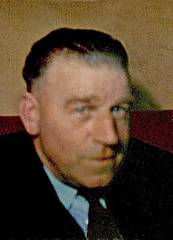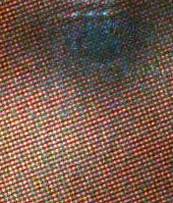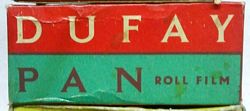| Dufaycolor |
 |
The picture alongside is taken from the BJPA for 1937 at a time (pre-July 1937) when Ilford was still marketing Dufaycolor roll film, 35mm film & film packs (Type D.1) and flat film & 16mm cine (Type D.2). "Dufaycolor is almost unlimited in its applications and unsurpassed for the quality of its results. Dufaycolor is sensitized by Ilford Limited and sold and distributed by them in the British Empire, British Mandated Territories and Egypt." See John Daly's site for more Dufaycolor information and useful links to others offering further information. Also some Dufaycolor examples taken about 1936 by John Daly's father, Melvin. See my Ilford chronology for years 1935 and 1937 for further information. |
|
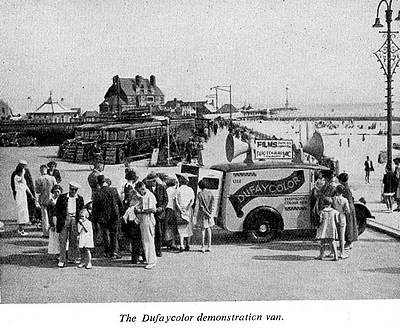 |
In 'Miniature Camera Magazine' (MCM) for October 1937, p702, there is the picture alongside and a short article entitled "Colour on Tour". "The picture shows an interested crowd around the Dufaycolor demonstration van. The van, equipped with the Marconiphone Public Address outfit has been creating great interest at Blackpool, and has been making a tour of the coast via Sunderland, Whitby, Scarborough, Hull, Grimsby, King's Lynn, Cromer, Great Yarmouth, Lowestoft, Harwich, Clacton-on-Sea to Southend for Carnival Week. Paul Godfrey recognises the resort in the photograph as Gorleston-on-Sea
a part of Great Yarmouth just up the coast from Lowestoft. Later, the van will come back to Blackpool for the Illuminations Week with its operators ready to give advice and information to the thousands of users of Dufaycolor who will undoubtedly embrace this opportunity of obtaining colour photographs of unique character." |
|
| In AP magazine for August 24th 1949, a Gifford Boyd advertisement lists Dufay Colour Flat Film, 3½"x2½" at 9s.11d (50p), ¼plate size at 14s.6d (73p), 9x12cm at 15s.3d (76p) & ½plate at 31s.6d (£1.58p). Dufaycolour Films, 120/620 cost 8s.9d each (44p), 18 exposure 35mm reloads cost 5s.9d (29p). The Johnsons processing outfit cost 10s.6d (53p). | ||
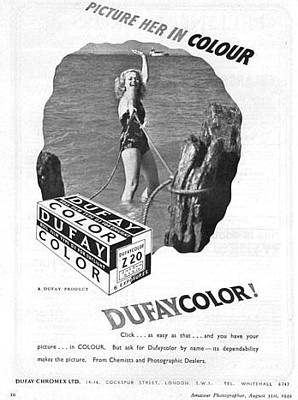 A Dufaycolor advertisement taken from Amateur Photographer for August 31st 1949. |
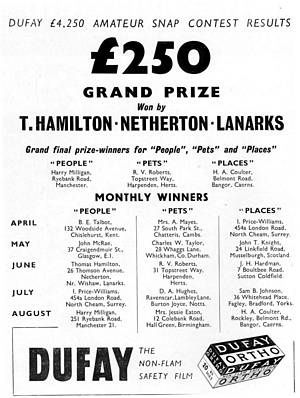 Dufay also sold black & white Orthochromatic film, as shown in this November 'Photography' advert sponsoring photographic competitions during 1951. |
Dufay orthochromatic film. Picture courtesy of Tony Pritchard |
|
Picture courtesy of Charlie Kamerman. |
||
|
In AP for 21st December 1949, Lewis & Newcombe advertise Dufay black & white Panchromatic 120 roll film (as above), 4 for 11s/8d plus 6d postage, so effectively 3/- each roll (15p). Its probable that both the Dufay ortho' and pan' films were rebranded Ilford films. 120 Ilford Selochrome (orthochromatic) is priced in the same 1949 advert at 10s/4d for 4 plus 6d postage, effectively 2s/8d each roll (13.5p). |
||
| Thanks to Brian Wilkinson for donating a small 4 sided leaflet (140mm by 206mm), printed in England for Dufay-Chromex Ltd; perhaps July 1938, describing 6 different viewers for Dufaycolor roll film transparencies. | ||
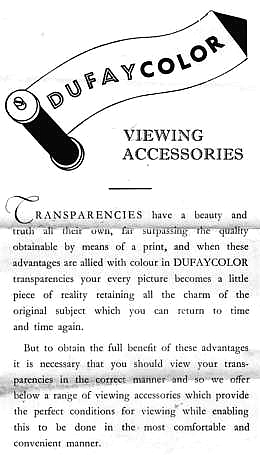 |
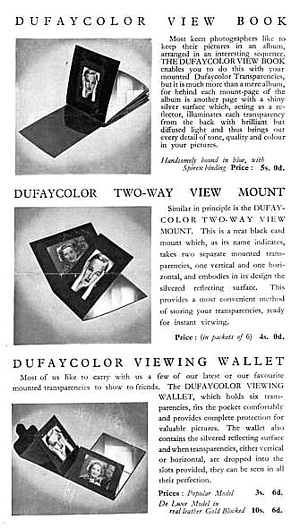 |
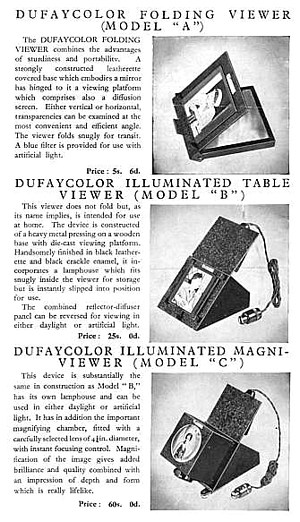 |
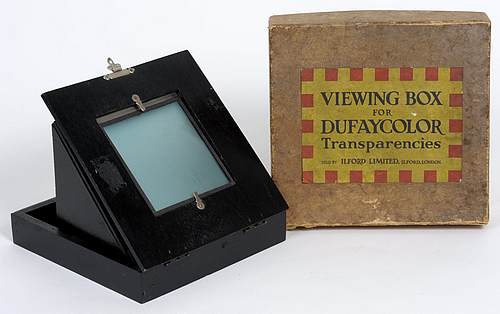 |
Doug McKee has sent me the picture alongside, which is a Dufaycolor viewer different from any shown in the above pamphlet. Doug says "The viewer is surprisingly crude in construction, being mostly 3/16 inch 3-ply (wood) apart from the square base frame which is solid wood. The only important bit not visible in the picture is the mirror in the base to reflect light through the transparency which is placed over the screen". From this description it seems to be a combination of the Model 'A' and the Model 'B' above, though made in wood, possibly (as Doug suggests) during war-time, when metal supplies were limited. The box lid says "Sold by Ilford, Limited, Ilford, London". |
|
| Click
here to see a full page advertisement, by Ilford Ltd, for
Dufaycolor film and a Viewing Box, in the Amateur Photographer
magazine for May 20th 1936. Tony Pritchard has sent me (August 2012) instructions copied from the original instruction sheet, for a viewer similar to the one illustrated. This makes clear that the angled support is where the transparency is positioned, but it is viewed within a mirror located on the inside base of the viewer 'box'. The instructions read: "Lift the folded panels and rest the side flaps of the viewing box on the supports provided. Then place the box so that the light falls on to the mirror via the matt diffuser. Then lift the TOP panel and insert the mounted transparency UPSIDE DOWN, and dull side towards the light, in the appropriate recessed portion of the lower panel. A brilliant coloured picture will then appear in the mirror. When viewing transparencies BY ARTIFICIAL LIGHT, insert the glass filter in the square recess in the top panel". |
||
|
Also from Tony Pritchard, to the right is a Dufaycolor slide in a genuine Dufaycolor slide mount (see far right, showing an enlarged section of the upper right hand corner of the mount, embossed Dufaycolor). The slide is dated 15th November 1937, taken at 1/15th second at f4.5. This long, wide aperture, exposure, demonstrates the slow speed of Dufaycolor. The slide is titled "Fosse Way", presumably the name of the house in the picture. |
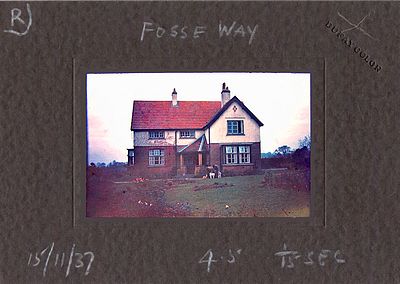 |
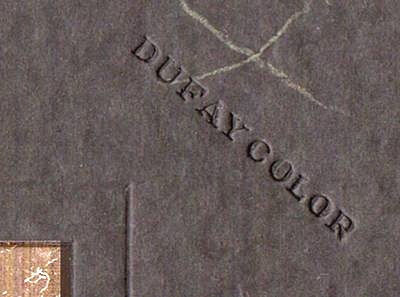 |
|
David Bayliss has a Dufaycolor transparency film that has been developed and the slides mounted, all in its original return wallet from the Dufay Chromex Ltd. processing station. Interestingly the literature includes a leaflet announcing a forthcoming service for Dufaycolor paper prints from 1st October 1938. This suggests his transparencies probably date from that year or slightly earlier. To see scans of three of David's slides, plus the accompanying packaging and leaflet about the forthcoming print service, click here. |
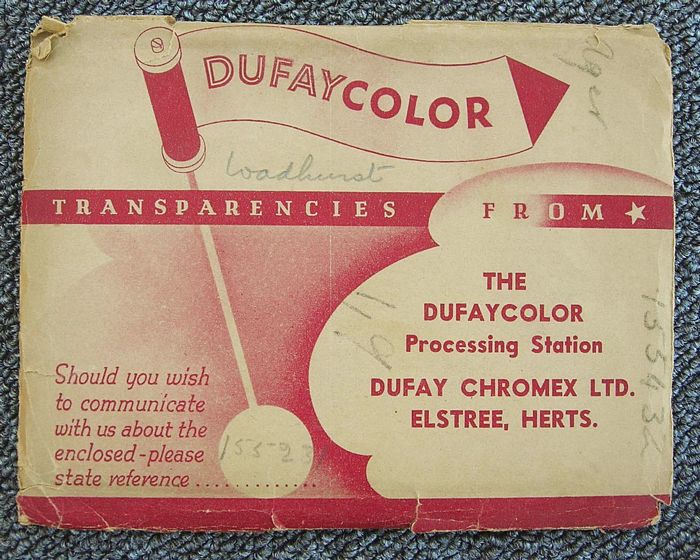 |
|
|
Pictured to the right are the front and rear of a Dufaycolor processing return envelope, with a date written on it of 1939. Envelope shown courtesy of Tony Pritchard. |
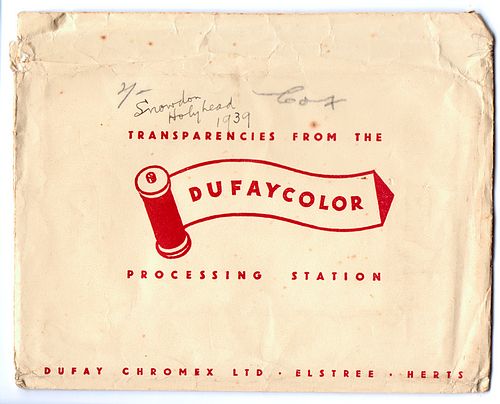 |
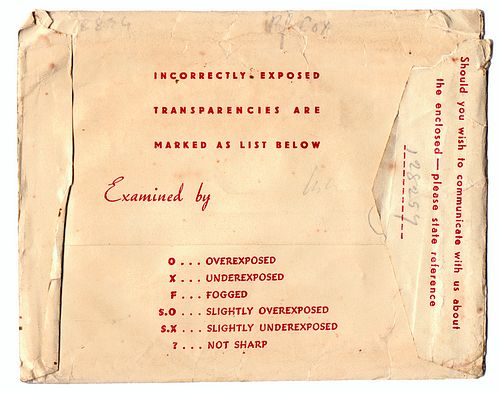 |
|
|
||
|
"When you are viewing DUFAYCOLOR transparencies, either in the hand or with one of the accessories described above, you should stand facing the light. If you are indoors, face the window, approaching as close as is convenient. See that the light reaching the reflector surface of the viewer is as white as possible. If you are viewing by artificial light the blue filter should be in position or the blue side of the reflector plate in operation. The transparency is placed in position on the viewing platform and the device arranged to secure the maximum degree of reflection. If you are examining an original, the emulsion (dull) side should be towards you. If it is a copy, the emulsion faces away from you. If you are using artificial light, a table-lamp will provide a suitable light source. Care should be taken to keep the reflector surfaces in the viewers clean and the lens in Model 'C' should also be kept free from dirt." |
||
 |
The viewing accessories are also mentioned in the publication, "The Dufaycolor Book", page 8 & Section IV. The 60 page Dufaycolor Book, measuring 143mm by 221mm, was issued by Duafy-Chromex Ltd around April 1947, a third Post-War expanded edition, costing 3/- (15p). A book bearing this same title was available in 1937 from Dufay-Chromex priced 8p (3.5p), post free. It describes in some detail the construction of Dufaycolor film, its exposure and reversal processing. An Amateur Photographer 31st January 1951 edition contains an advert (by Robinson & Sale, p16) for a Johnsons 'Dufay' Processsing Kit priced 10s/6d (52.5p). There is also a section on producing colour prints by the preparation of tri-color Separation Negatives, followed by their printing and registration into a complete colour print using DUFAYTISSUE. The Dufaytissue consists of: "A coating of coloured gelatine on a non-inflammable transparent film support, so compunded that it may be sensitised and developed and, after drying, transferred to a suitable gelatine coated white paper or card." The three images are superimposed on white paper, so forming the finished colour print. |
|
|
The above Dufaycolor Data book is believed to date around 1950 (cover picture and image alongside, courtesy of Michael Talbert). There is no publication date in he book, but at the back it gives a list of "Dufaycolor Distributors Overseas" as at 1st August 1949. Michael purchased this book from one of the many second hand book shops in Hay-on-Wye. The book deals with the exposure, processing and viewing of Dufaycolor transparencies, and suggests uses for Dufaycolor. The page alonside is from the above Dufaycolor Data book and shows how four colours are reproduced by the combination of a black & white panchromatic film emulsion and a superimposed transparent coloured 'reseau' with minute red, green and blue areas. The film worked by the developed silver "blocking off" some of the colours that would otherwise be transmitted by the reseau, with opposite colours showing through where there is clear film. |
 |
|
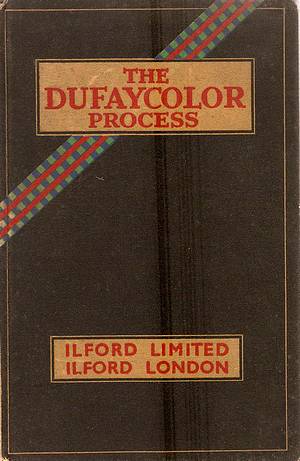 |
Another Dufaycolor book, this one positively identifying itself to Ilford Limited. This copy belongs to Paul Godfrey who kindly supplied scans of three colour illustrations, see right and below. The 10ASA speed of Dufaycolor film required lengthy exposures, as can be read in the text attaching to each picture. |
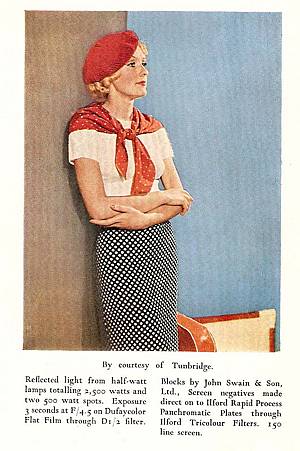 |
 |
|
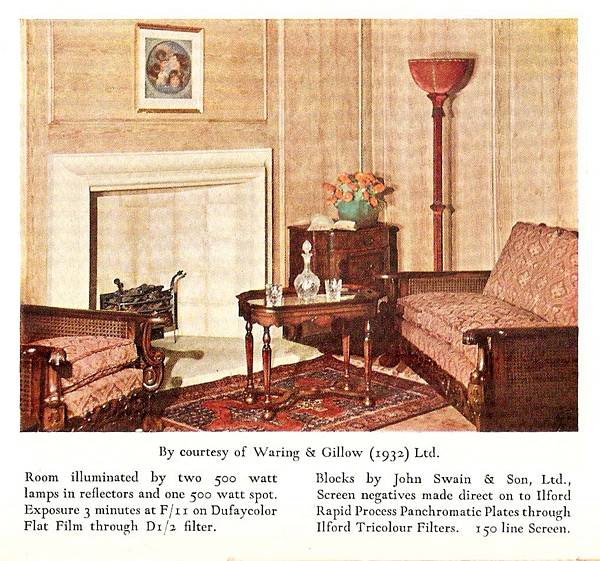 |
|
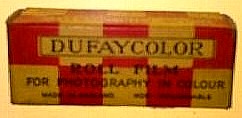 Although
processing was relatively simple (and instructions were published),
Ilford offered a service for roll films. A 120 size roll film,
for 6 exposures, cost 3s/4d (16.5p), over three times the cost
of an 8 exposure b&w film and developing (to colour transparencies)
cost another 1s/6d (7.5p). Hence, 6 Dufaycolor transparencies
cost a total of 4/10d (24p), more than £10 in 2005 money.
Although
processing was relatively simple (and instructions were published),
Ilford offered a service for roll films. A 120 size roll film,
for 6 exposures, cost 3s/4d (16.5p), over three times the cost
of an 8 exposure b&w film and developing (to colour transparencies)
cost another 1s/6d (7.5p). Hence, 6 Dufaycolor transparencies
cost a total of 4/10d (24p), more than £10 in 2005 money.